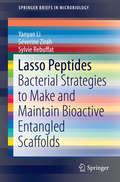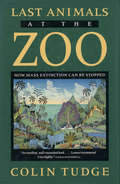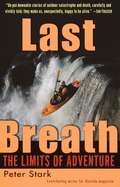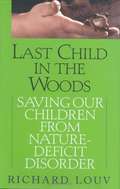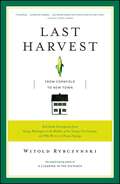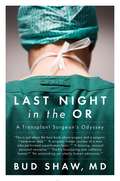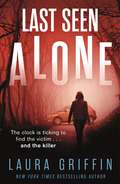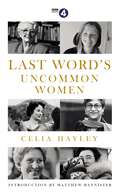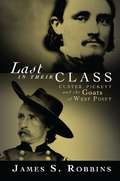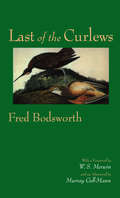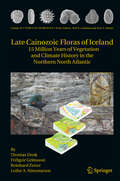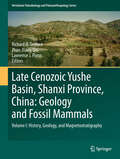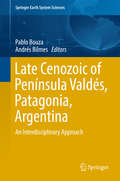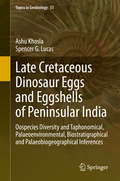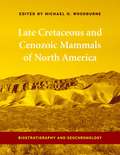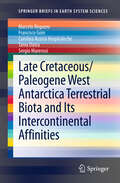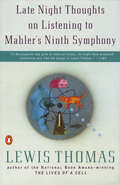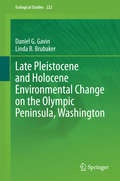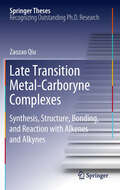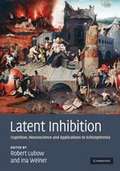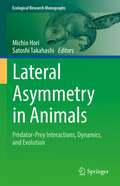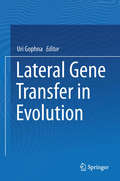- Table View
- List View
Lasso Peptides
by Sylvie Rebuffat Yanyan Li Séverine ZirahLasso peptides form a growing family of fascinating ribosomally-synthesized and post-translationally modified peptides produced by bacteria. They contain 15 to 24 residues and share a unique interlocked topology that involves an N-terminal 7 to 9-residue macrolactam ring where the C-terminal tail is threaded and irreversibly trapped. The ring results from the condensation of the N-terminal amino group with a side-chain carboxylate of a glutamate at position 8 or 9, or an aspartate at position 7, 8 or 9. The trapping of the tail involves bulky amino acids located in the tail below and above the ring and/or disulfide bridges connecting the ring and the tail. Lasso peptides are subdivided into three subtypes depending on the absence (class II) or presence of one (class III) or two (class I) disulfide bridges. The lasso topology results in highly compact structures that give to lasso peptides an extraordinary stability towards both protease degradation and denaturing conditions. Lasso peptides are generally receptor antagonists, enzyme inhibitors and/or antibacterial or antiviral (anti-HIV) agents. The lasso scaffold and the associated biological activities shown by lasso peptides on different key targets make them promising molecules with high therapeutic potential. Their application in drug design has been exemplified by the development of an integrin antagonist based on a lasso peptide scaffold. The biosynthesis machinery of lasso peptides is therefore of high biotechnological interest, especially since such highly compact and stable structures have to date revealed inaccessible by peptide synthesis. Lasso peptides are produced from a linear precursor LasA, which undergoes a maturation process involving several steps, in particular cleavage of the leader peptide and cyclization. The post-translational modifications are ensured by a dedicated enzymatic machinery, which is composed of an ATP-dependent cysteine protease (LasB) and a lactam synthetase (LasC) that form an enzymatic complex called lasso synthetase. Microcin J25, produced by Escherichia coli AY25, is the archetype of lasso peptides and the most extensively studied. To date only around forty lasso peptides have been isolated, but genome mining approaches have revealed that they are widely distributed among Proteobacteria and Actinobacteria, particularly in Streptomyces, making available a rich resource of novel lasso peptides and enzyme machineries towards lasso topologies.
Last Animals at the Zoo: How Mass Extinction Can Be Stopped
by Colin TudgeIn Last Animals at the Zoo, Colin Tudge argues that zoos have become an essential part of modern conservation strategy, and that the only real hope for saving many endangered species is through creative use of zoos in combination with restoration of natural habitats. From the genetics of captive breeding to techniques of behavioral enrichment, Tudge examines all aspects of zoo conservation programs and explains how the precarious existence of so many animals can best be protected.
Last Breath
by Peter Stark"Forget the edge of your seat. Last Breathtakes you to the edge of your life, for a pulse-pounding glimpse into the Great Beyond. There are many ways to risk your life in the out-of-doors, and Stark has captured them in exquisite and harrowing detail. " -JIM ROBBINS Author ofA Symphony in the Brain An enthralling blend of adventure and science, Last Breath re-creates in heart-stopping detail what happens to our bodies and our minds in the perilous last moments of life when an extreme adventure goes awry. Combining the adrenaline high of extreme sports with the startling facts of physiological reality, veteran travel and outdoor sports writer Peter Stark narrates a series of adventure stories in which thrill can cross the line to mortal peril. Each death or brush with death is at once a suspense story, a cautionary tale, and a medical thriller. Will they survive, or will they succumb? Readers will shiver with a man lost in the snowy woods, suffering from hypothermia and tearsing off his clothes as he's burning up from the cold; they will hallucinate with a young woman stranded at the top of Annapurna as she experiences a cerebral edema; and while a kayaker tumbles helplessly underwater for two minutes, five minutes, ten minutes, readers, too, will gasp for their last breath.
Last Breath: The Limits of Adventure
by Peter StarkSudden, extreme deaths have always fascinated us-- and now more than ever as athletes and travelers rise to the challenges of high-risk sports and journeys on the edge. In this spellbinding book, veteran travel and outdoor sports writer Peter Stark reenacts the dramas of what happens inside our bodies, our minds, and our souls when we push ourselves to the absolute limits of human endurance. Combining the adrenaline high of extreme sports with the startling facts of physiological reality, Stark narrates a series of outdoor adventure stories in which thrill can cross the line to mortal peril. Each death or brush with death is at once a suspense story, a cautionary tale, and a medical thriller. Stark describes in unforgettable detail exactly what goes through the mind of a cross-country skier as his body temperature plummets-- apathy at ninety-one degrees, stupor at ninety. He puts us inside the body of a doomed kayaker tumbling helplessly underwater for two minutes, five minutes, ten minutes. He conjures up the physiology of a snowboarder frantically trying not to panic as he consumes the tiny pocket of air trapped around his face under thousands of pounds of snow. These are among the dire situations that Stark transforms into harrowing accounts of how our bodies react to trauma, how reflexes and instinct compel us to fight back, and how, why, and when we let go of our will to live.In an increasingly tamed and homogenized world, risk is not only a means of escape but a path to spirituality. As Peter Stark writes, "You must try to understand death intimately and prepare yourself for death in order to live a full and satisfying life." In this fascinating, informative book, Stark reveals exactly what we’re getting ourselves into when we choose to live-- and die-- at the extremes of endurance.
Last Chance to Live
by Younan NowzaradanDr. Nowzaradan has dedicated much of his career to advocating quality medical management for the obese. While others were limiting weight loss surgery to those who weighed under 300-lbs., he was already performing safe laparoscopic weight loss surgery on super morbid obese individuals who weighed in excess of 600-lbs. Dr. Nowzaradan firmly believes in the care of the obese without discrimination or prejudice. In 2003, he performed laparoscopic weight loss surgery on the world's heaviest dad, heaviest mom, and heaviest teen. He has been featured in the hit TLC shows "Half Ton Killer," as well as "My 600-lb. Life," with the hope of influencing the public and the medical community to change their bias and negative opinion regarding severely obese individuals. Dr. Nowzaradan has become a beacon of hope for those who have struggled with their weight. He has changed the lives of many when others weren't willing to help them. As a doctor, he always helps to heal those that need it most.
Last Child in the Woods: Saving Our Children from Nature-Deficit Disorder
by Richard LouvFrom the Book Jacket: "I like to play indoors better 'cause that's where all the electrical outlets are," reports a fourth-grader. Never before in history have children been so plugged-in-and so out of touch with the natural world. In this groundbreaking new work, child advocacy expert Richard Louv direcdy links the lack of nature in the lives of today's wired generation-he calls it nature deficit-to some of the most disturbing childhood trends, such as rises in obesity, Attention Deficit Disorder (ADD), and depression. Some startling facts: By the 1990s the radius around the home where children were allowed to roam on their own had shrunk to a ninth of what it had been in 1970. Today, average eight-year- olds are better able to identify cartoon characters than native species, such as beetles and oak trees, in their own community. The rate at which doctors prescribe antidepressants to children has doubled in the last five years, and recent studies show that too much computer use spells trouble for the developing mind. Nature-deficit disorder is not a medical condition; it is a description of the human costs of alienation from nature. This alienation damages children and shapes adults, families, and communities. There are solutions, though, and they're right in our own backyards. Last Child in the Woods is the first book to bring together cutting-edge research showing that direct exposure to nature is essential for healthy childhood development-physical, emotional, and spiritual. What's more, nature is a potent therapy for depression, obesity, and ADD. Environment-based education dramatically improves standardized test scores and grade point averages and develops skills in problem solving, critical thinking, and decision making. Even creativity is stimulated by childhood experiences in nature. Yet sending kids outside to play is increasingly difficult. Computers, television, and video games compete for their time, of course, but it's also our fears of traffic, strangers, even virus- carrying mosquitoes-fears the media exploit- that keep children indoors. Meanwhile, schools assign more and more homework, and there is less and less access to natural areas. Parents have the power to ensure that their daughter or son will not be the "last child in the woods," and this book is the first step toward that nature-child reunion.
Last Harvest: From Cornfield to New Town
by Witold RybczynskiIn Last Harvest, the award-winning author of Home and A Clearing in the Distance tells the compelling story of New Daleville, a brand-new residential subdivision in rural Pennsylvania. When Witold Rybczynski first heard about New Daleville, it was only a developer's idea, attached to ninety acres of cornfield an hour and a half west of Philadelphia. Over the course of five years, Rybczynski met everyone involved in the transformation of this land -- from the developers, to the community leaders whose approvals they needed, to the home builders and sewage experts and, ultimately, the first families who moved in. Always eloquent and illuminating, Rybczynski looks at this "neotraditional" project, with its houses built close together to encourage a sense of intimacy and community, and explains the trends in American domestic architecture -- from where we place our kitchens and fences to why our bathrooms get larger every year. As Publishers Weekly said, "Rybczynski provides historical and cultural perspective in a style reminiscent of Malcolm Gladwell, debunking the myth of urban sprawl and explaining American homeowners' preference for single-family dwellings. But Rybczynski also excels at 'the close-up,' John McPhee's method of reporting, where every interview reads like an intimate conversation, and a simple walk down neighborhood sidewalks can reveal a wealth of history." Last Harvest is a charming must-read for anyone interested in where we live today -- and why -- by one of our most acclaimed and original cultural writers.
Last Night in the OR
by Bud ShawFor readers of Henry Marsh's Do No Harm, Paul A. Ruggieri's Confessions of a Surgeon, and Atul Gawande's Better -- a pioneering surgeon shares memories from a life in one of surgery's most demanding fields The 1980s marked a revolution in the field of organ transplants, and Bud Shaw, M.D., who studied under Tom Starzl in Pittsburgh, was on the front lines. Now retired from active practice, Dr. Shaw relays gripping moments of anguish and elation, frustration and reward, despair and hope in his struggle to save patients. He reveals harshly intimate moments of his medical career: telling a patient's husband that his wife has died during surgery; struggling to complete a twenty-hour operation as mental and physical exhaustion inch closer and closer; and flying to retrieve a donor organ while the patient waits in the operating room. Within these more emotionally charged vignettes are quieter ones, too, like growing up in rural Ohio, and being awakened late at night by footsteps in the hall as his father, also a surgeon, slipped out of the house to attend to a patient in the ER. In the tradition of Mary Roach, Jerome Groopman, Eric Topol, and Atul Gawande, Last Night in the OR is an exhilarating, fast-paced, and beautifully written memoir, one that will captivate readers with its courage, intimacy, and honesty.From the Trade Paperback edition.
Last Seen Alone: The heartpounding new thriller you won't be able to put down!
by Laura GriffinWith her signature breathless pacing and suspenseful twists and turns, 'Laura Griffin never fails to put me on the edge of my seat' (USA TODAY).If you love Karen Rose, Melinda Leigh and Lisa Gardner, you'll be gripped by Laura Griffin!'I love smart, sophisticated, fast-moving romantic thrillers and Laura Griffin writes them brilliantly' Jayne Ann Krentz'A pulse-pounding romantic thriller' Publishers Weekly.............................................................................................A missing victim. A merciless killer.Up-and-coming attorney Leigh Larson fights for victims of sexual extortion, harassment, and online abuse. She's laser-focused on her career and not afraid to go after the sleaziest targets to get payback for her clients. Austin homicide detective Brandon Reynolds is no stranger to midnight callouts, but his investigation of an abandoned car on a desolate road reveals an unusual crime scene. A pool of blood in the nearby woods suggests a brutal homicide. But where is the victim? The vehicle is registered to twenty-six-year-old Vanessa Adams, yet all Brandon finds inside is a smear of blood and a business card for Leigh Larson, attorney-at-law. Vanessa had hired Leigh just before her disappearance, but Leigh has no leads on who could have wanted her dead. Faced with bewildering evidence and shocking twists, Leigh and Brandon must work against the clock to chase down a ruthless criminal who is out for vengeance..............................................................................................Raves for Laura Griffin:'Desperate Girls is a nail-biting read from the very first page to the final, shocking twist. I could not put this book down' Melinda Leigh'Griffin pulls out all the stops in a phenomenal twist ending that will leave readers stunned' Publishers Weekly
Last Word's Uncommon Women
by Celia HayleyLast Word is the popular BBC Radio 4 series broadcast weekly, featuring the lives of several famous people who have recently died. More than standard obituaries, the lives are summarised with narration and include interviews with some of those who knew them. The programme was first broadcast in 2006 and this compelling anthology commemorates the remarkable and revealing lives of 80 women who were illuminating, inspiring or moving. Their names may not always be well known, but their lives made an impact on the world, and they broke new ground in many different ways. The book includes: Lt Islam Bibi - Helmand's top female police officer, shot dead by the Taliban Naty Revuelta Clews - Fidel Castro's mistress Naomi Sims - first Black supermodel Sylvia Robinson - The 'mother of hip-hop' who was the founder/CEO of Sugar Hill records Rosalia Mera - Zara founder, the world's richest self-made woman Marie Colvin - celebrated war reporter killed in Homs Clare Hollingworth - first war correspondent to report the outbreak of the Second World War Eileen Nearne - wartime spy who was captured and tortured by the Gestapo Salome Karwah - Ebola survivor who went back to Liberia to nurse other sufferers Jo Cox - MP murdered in her own Yorkshire constituency Jill Saward - rape survivor and campaigner for victims of sexual abuse Scharlette Holdman - 'The Angel of Death Row' who fought against the death penalty in the US Jeanne Cordova - former nun who became a lesbian rights activist Francis Kelsey - pharmacologist who prevented the licence of Thalidomide in the US Margaret Rule - archaeologist who raised the Mary Rose Countess of Arran - powerboat racer, 'the fastest granny on water'
Last Word's Uncommon Women
by Celia HayleyLast Word is the popular BBC Radio 4 series broadcast weekly, featuring the lives of several famous people who have recently died. More than standard obituaries, the lives are summarised with narration and include interviews with some of those who knew them. The programme was first broadcast in 2006 and this compelling anthology commemorates the remarkable and revealing lives of 80 women who were illuminating, inspiring or moving. Their names may not always be well known, but their lives made an impact on the world, and they broke new ground in many different ways. The book includes: Lt Islam Bibi - Helmand's top female police officer, shot dead by the Taliban Naty Revuelta Clews - Fidel Castro's mistress Naomi Sims - first Black supermodel Sylvia Robinson - The 'mother of hip-hop' who was the founder/CEO of Sugar Hill records Rosalia Mera - Zara founder, the world's richest self-made woman Marie Colvin - celebrated war reporter killed in Homs Clare Hollingworth - first war correspondent to report the outbreak of the Second World War Eileen Nearne - wartime spy who was captured and tortured by the Gestapo Salome Karwah - Ebola survivor who went back to Liberia to nurse other sufferers Jo Cox - MP murdered in her own Yorkshire constituency Jill Saward - rape survivor and campaigner for victims of sexual abuse Scharlette Holdman - 'The Angel of Death Row' who fought against the death penalty in the US Jeanne Cordova - former nun who became a lesbian rights activist Francis Kelsey - pharmacologist who prevented the licence of Thalidomide in the US Margaret Rule - archaeologist who raised the Mary Rose Countess of Arran - powerboat racer, 'the fastest granny on water'
Last in Their Class: Custer, Pickett and the Goats of West Point
by James S. RobbinsToday's Goat, the West Point cadet finishing at the bottom of his class, is a temporary celebrity among his classmates. But in the 19th century, he was something of a cult figure. Custer's contemporaries at the Academy believed that the same spirit of adventure that led him to carouse at local taverns motivated his dramatic cavalry attacks in the Civil War and afterwards. And the same willingness to accept punishment from Academy authorities also sent George Pickett into the teeth of the Union guns at Gettsyburg. The story James S. Robbins tells goes from the beginnings of West Point through the carnage of the Civil War to the grassy bluffs over the Little Big Horn. The Goats he profiles tell us much about the soul of the American solider, his daring, imagination and desire to prove himself against high odds.
Last of the Curlews (New Canadian Library)
by Fred BodsworthIn this conservation classic, originally published fifty–five years ago, Fred Bodsworth tells the story of a solitary Eskimo curlew's perilous migration and search for a mate. The lone survivor comes to stand for the entirety of a species on the brink of extinction, and for all in nature that is endangered. This new paperback edition includes a foreword by Pulitzer Prize–winning poet W.S. Merwin and an afterword by Nobel Prize–winning physicist Murray Gell–Mann.
Late Cainozoic Floras of Iceland
by Friðgeir Grimsson Leifur A. Símonarson Reinhard Zetter Thomas DenkBeing the only place in the northern North Atlantic yielding late Cainozoic terrestrial sediments rich in plant fossils, Iceland provides a unique archive for vegetation and climate development in this region. This book includes the complete plant fossil record from Iceland spanning the past 15 million years. Eleven sedimentary rock formations containing over 320 plant taxa are described. For each flora, palaeoecology and floristic affinities within the Northern Hemisphere are established. The exceptional fossil record allows a deeper understanding of the role of the "North Atlantic Land Bridge" for intercontinental plant migration and of the Gulf Stream-North Atlantic Current system for regional climatic evolution. 'Iceland sits as a "fossil trap" on one of the most interesting biogeographic exchange routes on the planet - the North Atlantic. The fossil floras of Iceland document both local vegetational response to global climate change, and more importantly, help to document the nature of biotic migration across the North Atlantic in the last 15 million years. In this state-of-the-art volume, the authors place sequential floras in their paleogeographic, paleoclimatic and geologic context, and extract a detailed history of biotic response to the dynamics of physical change.' Bruce H. Tiffney, University of California, Santa Barbara 'This beautifully-illustrated monograph of the macro- and microfloras from the late Cenozoic of Iceland is a worthy successor to Oswald Heer's "Flora fossilis arctica". Its broad scope makes it a must for all scientists interested in climatic change and palaeobiogeography in the North Atlantic region. It will remain a classic for years to come.' David K. Ferguson, University of Vienna
Late Cenozoic Yushe Basin, Shanxi Province, China: Volume I:History, Geology, and Magnetostratigraphy
by Lawrence J Flynn Richard H Tedford Zhan-Xiang QiuThe Late Cenozoic Yushe Basin, Shanxi Province, China embodies the bulk of our knowledge on successions of terrestrial vertebrates in the northern part of East Asia. Everything we know about Asian mammals of the last 6 million years has a historical basis in the documentation of the geology of Yushe. This volume introduces the basin in its geological setting, describes the succession of fossiliferous strata, and shows how it is dated. It develops an unsurpassed level of precision for its age control. Geological maps and stratigraphic sections provide the backbone for individual studies to follow on varied fossil groups. The volume explores the history of exploration of the last century in Yushe Basin and places development of paleontology there into the context of the birth of the modern epoch of science in China.
Late Cenozoic of Península Valdés, Patagonia, Argentina: An Interdisciplinary Approach (Springer Earth System Sciences)
by Pablo Bouza Andrés BilmesThis book presents extensive and new information on the Cenozoic marine and continental systems of one of the most important World Heritage sites of Southern South America: The Península Valdés. Using an interdisciplinary approach, that includes geological, biological and archeological perspectives of more than 30 specialists, an integrated description and analysis of the Cenozoic environments of the study region is presented. The volume brings together an update of the geology, climate, geomorphology, soils, biodiversity, archeology and human impact of the Península Valdés. The scope of this book extends to any natural science researcher of the world interested on the Cenozoic history of the Península Valdés.
Late Cretaceous Dinosaur Eggs and Eggshells of Peninsular India: Oospecies Diversity and Taphonomical, Palaeoenvironmental, Biostratigraphical and Palaeobiogeographical Inferences (Topics in Geobiology #51)
by Spencer G. Lucas Ashu KhoslaThis book documents analyses of the Late Cretaceous dinosaur nesting sites of the Lameta Formation at Jabalpur, Districts Dhar and Jhabua, Madhya Pradesh; Districts Kheda and Panchmahal (Gujarat); and the Pisdura, Dongargaon and Pavna sectors in the Chandrapur Districts of Maharashtra, which are exposed in India along an east-west and central axis. In this work, special emphasis has been given to the dinosaur nesting sites of the east-central Narbada River region, including its regional geology. The work was undertaken to provide detailed information concerning dinosaur eggs, eggshell fragments, nests and clutches found in the Lameta Formation of peninsular India. Prior to the present work there had been no detailed review of systematic work on the taxonomy, and of micro- and ultrastructural studies of dinosaur eggs and eggshells from the Lameta Formation. The study documents the field and laboratory investigations that facilitated the reconstruction of the morphotaxonomy, models for the burial pattern of eggs and eggshells, taphonomic implications,and the palaeoenvironmental context and palaeoecological conditions during the Late Cretaceous at the time of the extrusion of the Deccan traps, which may have been partly responsible for the extinction of the dinosaurs. The need to follow a parataxonomic classification for Indian dinosaur eggs and eggshell types is very apparent, and this book addresses this aspect in some detail. The emphasis on the application of parataxonomic schemes is based on the description of new oospecies and their comparison with previously known forms. The present work has led to the recovery of numerous nests, many collapsed eggs and hundreds of dinosaur eggshell fragments from the localities situated near the east, west and central Narbada River regions. It will be of interest to academics and professional palaeontologists, and all students of dinosaurs.
Late Cretaceous and Cenozoic Mammals of North America: Biostratigraphy and Geochronology
by Michael WoodburneThis book places into modern context the information by which North American mammalian paleontologists recognize, divide, calibrate, and discuss intervals of mammalian evolution known as North American Land Mammal Ages. It incorporates new information on the systematic biology of the fossil record and utilizes the many recent advances in geochronologic methods and their results. The book describes the increasingly highly resolved stratigraphy into which all available temporally significant data and applications are integrated. Extensive temporal coverage includes the Lancian part of the Late Cretaceous, and geographical coverage includes information from Mexico, an integral part of the North American fauna, past and present.
Late Cretaceous/Paleogene West Antarctica Terrestrial Biota and its Intercontinental Affinities
by Marcelo Reguero Francisco Goin Tania Dutra Sergio Marenssi Carolina Acosta HospitalecheOne of the most intriguing paleobiogeographical phenomena involving the origins and gradual sundering of Gondwana concerns the close similarities and, in most cases, inferred sister-group relationships of a number of terrestrial and freshwater vertebrate taxa, e.g., dinosaurs, flying birds, mammals, etc., recovered from uppermost Cretaceous/ Paleogene deposits of West Antarctica, South America, and NewZealand/Australia. For some twenty five extensive and productive investigations in the field of vertebrate paleontology has been carried out in latest Cretaceous and Paleogene deposits in the James Ross Basin, northeast of the Antarctic Peninsula (AP), West Antarctica, on the exposed sequences on James Ross, Vega, Seymour (=Marambio) and Snow Hill islands respectively. The available geological, geophysical and marine faunistic evidence indicates that the peninsular (AP) part of West Antarctica and the western part of the tip of South America (Magallanic Region, southern Chile) were positioned very close in the latest Cretaceous and early Paleogene favoring the "Overlapping" model of South America-Antarctic Peninsula paleogeographic reconstruction. Late Cretaceous deposits from Vega, James Ross, Seymour and Snow Hill islands have produced a discrete number of dinosaur taxa and a number of advanced birds together with four mosasaur and three plesiosaur taxa, and a few shark and teleostean taxa.
Late Night Thoughts on Listening to Mahler's Ninth Symphony
by Lewis ThomasThis magnificent collection of essays by scientist and National Book Award-winning writer Lewis Thomas remains startlingly relevant for today’s world. Luminous, witty, and provocative, the essays address such topics as “The Attic of the Brain,” “Falsity and Failure,” “Altruism,” and the effects the federal government’s virtual abandonment of support for basic scientific research will have on medicine and science.Profoundly and powerfully, Thomas questions the folly of nuclear weaponry, showing that the brainpower and money spent on this endeavor are needed much more urgently for the basic science we have abandoned—and that even medicine’s most advanced procedures would be useless or insufficient in the face of the smallest nuclear detonation. And in the title essay, he addresses himself with terrifying poignancy to the question of what it is like to be young in the nuclear age. “If Wordsworth had gone to medical school, he might have produced something very like the essays of Lewis Thomas.”—TIME “No one better exemplifies what modern medicine can be than Lewis Thomas.”—The New York Times Book Review
Late Pleistocene and Holocene Environmental Change on the Olympic Peninsula, Washington
by Daniel G. Gavin Linda B. BrubakerThis study brings together decades of research on the modern natural environment of Washington's Olympic Peninsula, reviews past research on paleoenvironmental change since the Late Pleistocene, and finally presents paleoecological records of changing forest composition and fire over the last 14,000 years. The focus of this study is on the authors' studies of five pollen records from the Olympic Peninsula. Maps and other data graphics are used extensively. Paleoecology can effectively address some of these challenges we face in understanding the biotic response to climate change and other agents of change in ecosystems. First, species responses to climate change are mediated by changing disturbance regimes. Second, biotic hotspots today suggest a long-term maintenance of diversity in an area, and researchers approach the maintenance of diversity from a wide range and angles (CITE). Mountain regions may maintain biodiversity through significant climate change in 'refugia': locations where components of diversity retreat to and expand from during periods of unfavorable climate (Keppel et al. , 2012). Paleoecological studies can describe the context for which biodiversity persisted through time climate refugia. Third, the paleoecological approach is especially suited for long-lived organisms. For example, a tree species that may typically reach reproductive sizes only after 50 years and remain fertile for 300 years, will experience only 30 to 200 generations since colonizing a location after Holocene warming about 11,000 years ago. Thus, by summarizing community change through multiple generations and natural disturbance events, paleoecological studies can examine the resilience of ecosystems to disturbances in the past, showing how many ecosystems recover quickly while others may not (Willis et al. , 2010).
Late Transition Metal-Carboryne Complexes
by Zaozao QiuZaozao Qiu shows in this thesis that transition metals can mediate or catalyze the cycloaddition or coupling reactions of carboryne with alkynes or alkenes to afford benzocarboranes, alkenylcarboranes or dihydrobenzocarboranes. These results represent powerful strategies to assemble useful complex molecules from very simple precursors in a single operation. Carboranes have many applications in medicine. However, their unique structures make derivatization difficult and the limited efficient synthetic methods to obtain functional carborane materials have restricted applications of carboranes within a narrow scope. This work breaks a new ground in metal-carboryne chemistry and will have a significant impact on synthetic, cluster and materials chemistry.
Latent Inhibition: Cognition, Neuroscience and Applications to Schizophrenia
by R. E. Lubow Ina WeinerLatent inhibition is a phenomenon by which exposure to an irrelevant stimulus impedes the acquisition or expression of conditioned associations with that stimulus. Latent inhibition, an integral part of the learning process, is observed in many species. This comprehensive collection of studies of latent inhibition, from a variety of disciplines including behavioural/cognitive psychology, neuroscience and genetics, focuses on abnormal latent inhibition effects in schizophrenic patients and schizotypal normals. Amongst other things, the book addresses questions such as, is latent inhibition an acquisition or performance deficit? What is the relationship of latent inhibition to habituation, extinction, and learned irrelevance? Does reduced latent inhibition predict creativity? What are the neural substrates, pharmacology, and genetics of latent inhibition? What do latent inhibition research and theories tell us about schizophrenia? This book provides a single point of reference for neuroscience researchers, graduate students, and professionals, such as psychologists and psychiatrist
Lateral Asymmetry in Animals: Predator-Prey Interactions, Dynamics, and Evolution (Ecological Research Monographs)
by Satoshi Takahashi Michio HoriThis book presents the latest research findings on the laterality of fish and other animals. It describes all aspects of lateral asymmetry, including ecology, morphology, behaviour, dynamics of lefty and righty morphs, genetics and evolution, through field observations, experiments and modeling. Lateral asymmetry in scale-eating cichlids gives a simple and beautiful example of negative frequency-dependent selection and resulting oscillation of lefty and righty morph frequencies. Lateral dimorphism is found not only in scale-eaters but in all orders of fish, shrimps and cuttlefish. Lateral asymmetry interacts between species through "cross-predation." Contrary to fish, lateral asymmetry in snails acts as, in most cases, positive frequency-dependent selection and provides deep insights into speciation. Especially, snakes eating righty snails facilitate speciation of lefty snails.As a collaboration work of field ecologists and theoretical biologists, this book covers a variety of topics on lateral asymmetry, which are consistently related to predation. The topics include behavioral ecology, population dynamics, physiology, evolution, genetics, development, learning and neuroscience, statistics, with the subjects of fish, shrimp, prawn, and crayfish, crab, cuttlefish, and snake and snail. Chapters cover new research results such as cuttlefish laterality dynamics, interaction between laterality of snails and snakes, evolution of laterality genetic system, and statistical analysis of laterality oscillation. Readers will appreciate the simplicity and beauty of lateral asymmetry and its profound impact on ecology and evolution.
Lateral Gene Transfer in Evolution
by Uri GophnaAlthough the phenomenon of lateral gene transfer has been known since the 1940's, it was the genomics era that has really revealed the extent and many facets of this evolutionary/genetic phenomenon. Even in the early 2000s with but a handful of genomes available it became clear that the nature of microorganisms is full of genetic exchange between lineages that are sometimes far apart. The years following this saw an explosion of genomic data, which shook the 'tree of life' and also raised doubts about the most appropriate species concepts for prokaryotes. This book attempts to represent the many-fold contributions of LGT to the evolution of micro and, to an extent, macro-organisms by focusing on the areas where the Editor felt it had the largest impact: metabolic innovations and adaptations and speciation.
